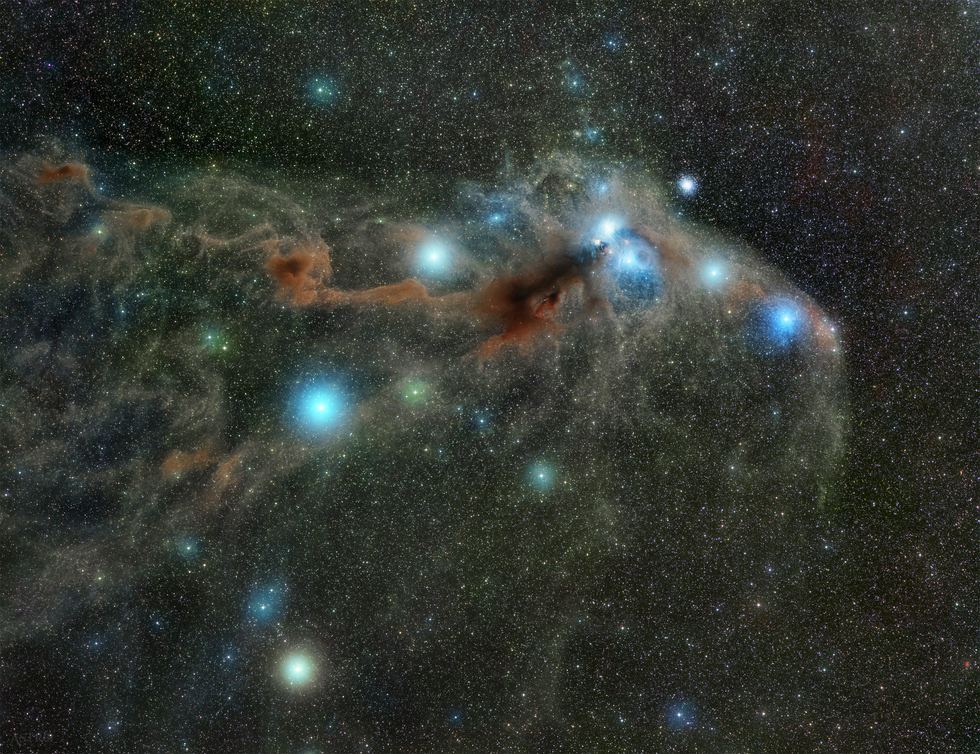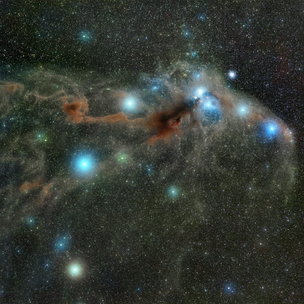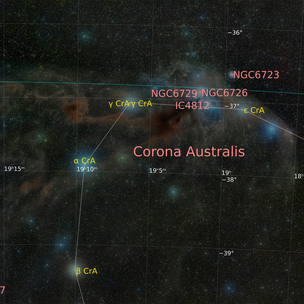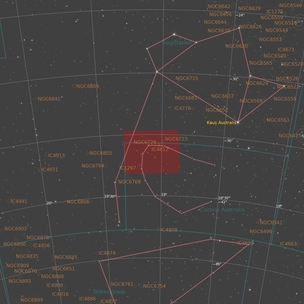Corona Australis Molecular Cloud
0
15
Corona Australis Molecular Cloud
The Corona Australis Molecular Cloud is a dark molecular cloud just north of Beta Coronae Australis. Illuminated by a number of embedded reflection nebulae the cloud fans out from Epsilon Coronae Australis eastward along the constellation border with Sagittarius. It contains 7000 M☉, Herbig–Haro objects (protostars) and some very young stars, being one of the closest star-forming regions, 430 light years (130 parsecs) to the Solar System, at the surface of the Local Bubble. The first nebulae of the cloud were recorded in 1865 by Johann Friedrich Julius Schmidt.The dust of the cloud is illuminated blue by starlight. Stars that are forming inside the cloud could only be detected by observing at longer wavelengths.
Detail of the star-forming region and Coronet Cluster, with the distinct Herbig–Haro object HH 100/Bernes 158 to the left.
Between Epsilon and Gamma Coronae Australis the cloud consists of the particular dark nebula and star forming region Bernes 157. It is 55 by 18 arcminutes wide and possesses several stars around magnitude 13. These stars are dimmed by up to 8 magnitudes because of the obscuring dust clouds. At the center of the active star-forming region lies the Coronet cluster (also called R CrA Cluster), which is used in studying star and protoplanetary disk formation. R Coronae Australis (R CrA) is an irregular variable star ranging from magnitudes 9.7 to 13.9. Blue-white, it is of spectral type B5IIIpe. A very young star, it is still accumulating interstellar material. It is obscured by, and illuminates, the surrounding nebula, NGC 6729, which brightens and darkens with it. The nebula is often compared to a comet for its appearance in a telescope, as its length is five times its width. Other stars of the cluster include S Coronae Australis, a G-class dwarf and T Tauri star.
Nearby north, another young variable star, TY Coronae Australis, illuminates another nebula: reflection nebula NGC 6726/NGC 6727. TY Coronae Australis ranges irregularly between magnitudes 8.7 and 12.4, and the brightness of the nebula varies with it. Blue-white, it is of spectral type B8e. The largest young stars in the region, R, S, T, TY and VV Coronae Australis, are all ejecting jets of material which cause surrounding dust and gas to coalesce and form Herbig–Haro objects, many of which have been identified nearby.
Not part of it is the globular cluster known as NGC 6723, which can be seen adjacent to the nebulosity in the neighbouring constellation of Sagittarius, but is much much further away.
(Source: Wikipedia)
Detail of the star-forming region and Coronet Cluster, with the distinct Herbig–Haro object HH 100/Bernes 158 to the left.
Between Epsilon and Gamma Coronae Australis the cloud consists of the particular dark nebula and star forming region Bernes 157. It is 55 by 18 arcminutes wide and possesses several stars around magnitude 13. These stars are dimmed by up to 8 magnitudes because of the obscuring dust clouds. At the center of the active star-forming region lies the Coronet cluster (also called R CrA Cluster), which is used in studying star and protoplanetary disk formation. R Coronae Australis (R CrA) is an irregular variable star ranging from magnitudes 9.7 to 13.9. Blue-white, it is of spectral type B5IIIpe. A very young star, it is still accumulating interstellar material. It is obscured by, and illuminates, the surrounding nebula, NGC 6729, which brightens and darkens with it. The nebula is often compared to a comet for its appearance in a telescope, as its length is five times its width. Other stars of the cluster include S Coronae Australis, a G-class dwarf and T Tauri star.
Nearby north, another young variable star, TY Coronae Australis, illuminates another nebula: reflection nebula NGC 6726/NGC 6727. TY Coronae Australis ranges irregularly between magnitudes 8.7 and 12.4, and the brightness of the nebula varies with it. Blue-white, it is of spectral type B8e. The largest young stars in the region, R, S, T, TY and VV Coronae Australis, are all ejecting jets of material which cause surrounding dust and gas to coalesce and form Herbig–Haro objects, many of which have been identified nearby.
Not part of it is the globular cluster known as NGC 6723, which can be seen adjacent to the nebulosity in the neighbouring constellation of Sagittarius, but is much much further away.
(Source: Wikipedia)
SPECIFICATIONS
Telescope
Takahashi FSQ-106ED
Camera
FLI PL16083
Location
Heaven's Mirror Observatory, Australia
Date of observation
June 2021 - September 2022
Filters
Astrodon LRGB
Processing
Processed in PixInsight and Photoshop






